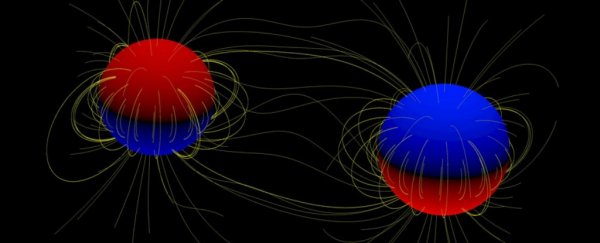Earlier this year, after 100 years of searching for them, an international team of researchers detected the presence of gravitational waves for the first time, thanks to the collision of two massive black holes, providing proof for Einstein's general theory of relativity.
Needless to say, it was a big deal, but two important questions remained: where did the two colliding black holes that created these gravitational ripples in space-time come from, and how did they get so massive?
Black holes form when a star runs out of fuel and collapses in on itself.
But for two black holes to end up so massive - they were both about 29 to 36 times the mass of our Sun - two stars must have existed that were even more gigantic, because by the time stars collapse into black holes, they've already lost most of their mass.
That's a problem, because it's thought that stars can't accumulate enough mass to make such massive black holes.
The issue is that when stars reach a size large enough to spawn such an epic black hole, they create so much energy that stellar winds rip most of their mass away, throwing it out into the Universe to be lost.
This leaves the star up to half the mass it once was - and not nearly big enough to produce a black hole of the size detected in the gravitational wave data.
So, how did two stars contain enough mass to form the two behemoth black holes? One idea is that they might have contained hardly any elements heavier than helium in their cores.
Heavier elements such as carbon, oxygen, and iron are all more likely to be blasted away by those stellar winds and be lost to space. So a star with hardly any metallic elements could potentially get to the sizes we're talking about - but is that the only option?
An international team of scientists has proposed another idea: magnetic fields.
The team, led by Véronique Petit from the Florida Institute of Technology, found evidence that a star could retain the amount of mass required to create the black holes if that they maintained vast magnetic fields roughly 10,000 times more powerful than the Sun's.
The general idea here is that those powerful magnetic fields would surround the massive star and help catch much of that lost mass that is being swept into space and feed it back into the star, preserving its massiveness for an eventual collapse. In that way, its black hole could reach the sizes detected by the gravitational wave data.
"Strong surface magnetic fields also provide a powerful mechanism for modifying mass loss and rotation of massive stars," the team writes.
To test this hypothesis, they created a series of computer simulations to see how a gigantic star's mass might change over time if a magnetic field of such magnitude was present.
In the end, they found that if they took a star that was about 80 times the mass of the Sun, covered it in strong magnetic fields, and waited for it to eventually collapse, the mass left at the end of the star's life was way more than if there wasn't a magnetic field.
About 20 times the mass of the Sun, to be specific.
Based on this, the team says we need to consider the possibility that massive black holes might rely on extremely magnetic stars to form, though they also caution that proving this hypothesis will likely mean observing such an event happening in the Universe, which - as you can probably imagine - is no easy task.
"This is an interesting alternative hypothesis for how stars can end up holding onto more of their mass, so they can form such heavy black holes. [But], the mechanism is somewhat speculative," astrophysicist Vicky Kalogera from Northwestern University, who was not part of the study, told Science News.
But the good news is that the team's hypothesis is definitely a step in the right direction if we ever hope to fully understand how the Universe was formed and how it continues to operate.
And now we have a new type of star to look for as the source of these huge black holes.
The team's work was published in Monthly Notices of the Royal Astronomical Society.
